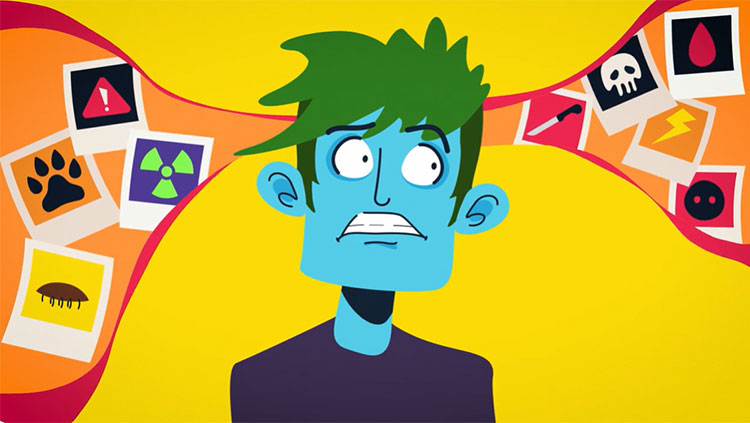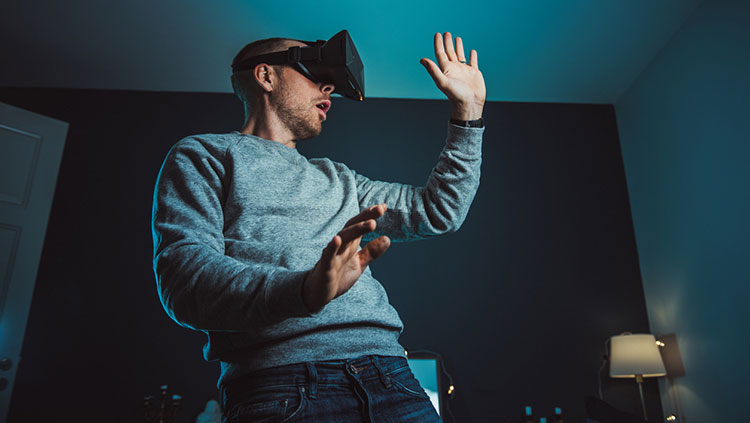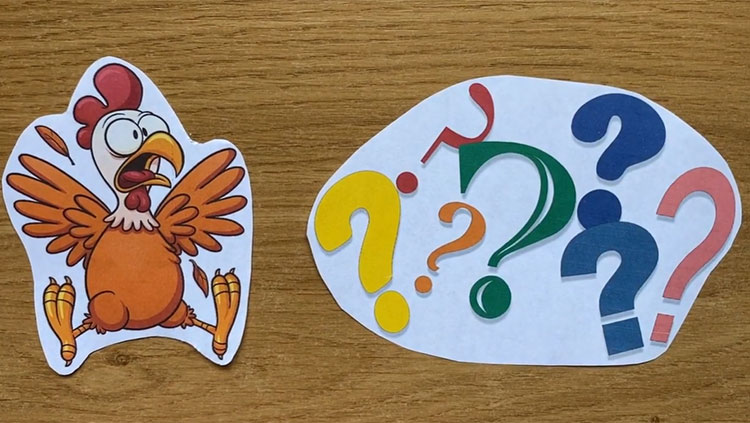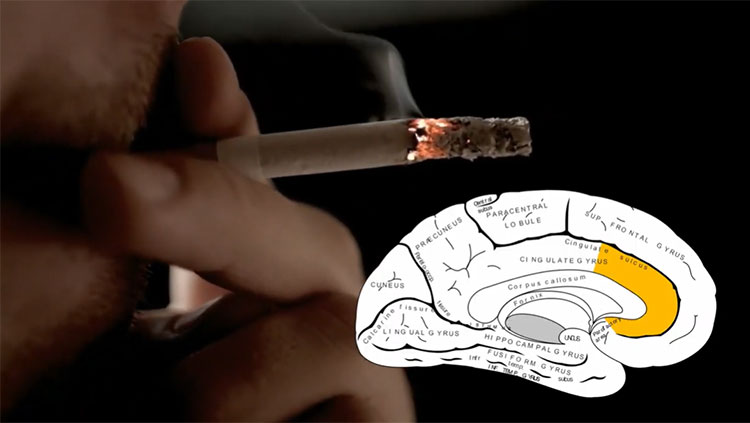Testing the Tingles: The Science Behind ASMR
- Published2 Feb 2021
- Author Melissa Mayer
- Source BrainFacts/SfN
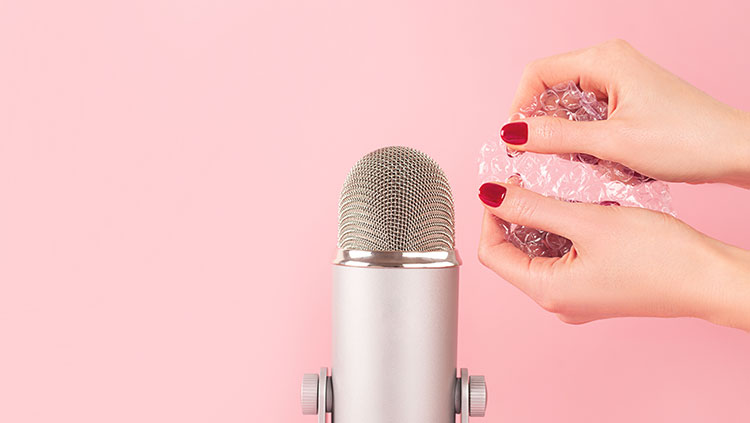
For as long as she can remember, Giulia Poerio has experienced a tingling sensation in her scalp when listening to people whisper. “I asked [my sister] if she got this head tingling thing when people were whispering,” the University of Essex researcher recalls. “She said she thought it was really weird, so I never spoke about it to anybody else.”
In 2013, Poerio learned the sensation had a name: ASMR, or autonomous sensory meridian response.
If you’ve spent any time on YouTube, you’ve probably come across videos of people whispering, tapping, or gently handling objects — serenely folding clothes, say, or slowly combing their hair. The videos, created by self-described ASMRtists, are designed to evoke the tingly sense of calm and contentment that characterizes ASMR. Some even roleplay real-life experiences that trigger ASMR — like getting an eye exam or haircut.
Now, Poerio and other scientists are beginning to unravel what’s happening in the brains of people who experience ASMR.
ASMR in the Lab
ASMR first hit the public consciousness in 2007 when a user described the experience in an online message board. Since then, the phenomenon has exploded. In 2019, the top 10 ASMRtists racked up a collective 5.7 trillion views. It’s so popular that celebrities like Cardi B and Jeff Goldblum have gotten in on the action with their own videos.
When Poerio first came across ASMR, she immediately began looking for peer-reviewed studies. “There wasn't anything!” she says. “The only thing I found at that time was a really small mention in a paper.”
So, she decided to study the phenomenon herself.
She recruited 112 participants for a study, half of whom said they experienced ASMR. She hooked them up to electrodes and showed them a video of an ASMRtist folding towels. They also selected one of their favorite ASMR video clips to watch.
While watching the videos, participants’ heart rates fell – a sign of relaxation. But they also perspired more, indicating heightened emotional arousal. “That’s something we didn't predict,” Poerio says. “[ASMR] seems to be both activating and deactivating at the same time. And that's quite characteristic of other complex emotional experiences like nostalgia or awe.”
The Brain on ASMR
Physiologist Craig Richard first learned about ASMR from a podcast. “I'd never heard that term before, so I was immediately skeptical,” says Richard, a professor at Shenandoah University. But he quickly realized the description gave a name to the fuzzy, relaxed feeling he’d always enjoyed while doing things like getting a haircut or watching Bob Ross videos. That piqued his curiosity.
He wanted to know what was happening in the brain during an ASMR episode. In a 2018 study he co-authored, 10 people reviewed ASMR videos and picked clips that triggered their ASMR. Participants watched the videos while undergoing MRI scans of their brains, pushing a button inside the MRI scanner to let the researchers know when they felt relaxed or had tingles.
ASMR tingles lit up many brain areas, including ones that process reward, emotional arousal, and social behaviors.
“It wasn't too surprising to see the association with reward,” Richard says. “Emotional arousal was a little bit curious because [ASMR] isn’t considered arousing in an emotional way like joy and excitement are, but it does seem to have low-grade euphoria with it.”
Richard was most intrigued by the activity in the medial prefrontal cortex, the hub of the brain’s social network. Animals use social behaviors like grooming or caring for distraught infants to build social bonds. Those things look a lot like what happens in ASMR videos: slow movements, gentle touches, caring looks.
ASMR might be a variation of this social behavior — like virtual grooming. “It's even a step beyond that because it's virtual grooming by a stranger,” adds Richard. ASMR videos check all the boxes of nurturing social interactions: “someone talks to you gently, looks at you with genuine care, doesn't make any threatening movements,” Richard says. “Then your brain automatically begins to move towards trust, which may involve this release of oxytocin and lighting up certain areas of the brain.”
Looking Forward
Oxytocin and other neurotransmitters like dopamine, serotonin, and endorphins may play roles in ASMR. Richard thinks individual differences in the number and sensitivity of receptors for those neurotransmitters could explain why some people don’t experience ASMR.
A different sensory phenomenon may hold another clue. In an MRI study, researchers found people who experience chills while listening to music possess more connections between the brain’s auditory and emotion-processing regions. “I suspect there might be a similar thing going on with ASMR, but no one's done that yet,” Poerio says.
Just last year, another group of researchers found people with ASMR have altered patterns of connectivity in the resting state network, a collection of structures that activate when the brain is idle. That might make it easier to experience complex emotions like ASMR, Poerio says.
Poerio hopes to bring all these threads of research together. She and colleagues Tom Hostler of Manchester Metropolitan University and Tom Swart of Goldsmiths University are launching an interdisciplinary research network to bring scientists together and set an agenda for ASMR research.
Despite the evidence uncovered so far, ASMR faces skepticism — especially from people who don’t experience it themselves. Richard says that skepticism could actually drive the push for more research. “[People] should want to see data and lots of published research to be convinced of what it is, how it works, and how it could be utilized,” he explained.
CONTENT PROVIDED BY
BrainFacts/SfN
References
ASMR University. (2014). ASMR University. https://asmruniversity.com/
ASMRNet: Establishing a global research network and prioritised agenda for ASMR. (n.d.). Crowd.Science. Retrieved January 15, 2021, from https://crowd.science/campaigns/asmrnet-establishing-a-global-research-network-and-prioritised-agenda-for-asmr/
Cash, D. K., Heisick, L. L., & Papesh, M. H. (2018). Expectancy effects in the Autonomous Sensory Meridian Response. PeerJ, 6, e5229. https://doi.org/10.7717/peerj.5229
Hostler, T. J., Poerio, G. L., & Blakey, E. (2019). Still More Than a Feeling: Commentary on Cash et al., “Expectancy Effects in the Autonomous Sensory Meridian Response” and Recommendations for Measurement in Future ASMR Research. Multisensory Research, 32(6), 521–531. https://doi.org/10.1163/22134808-20191366
Lochte, B. C., Guillory, S. A., Richard, C. A. H., & Kelley, W. M. (2018). An fMRI investigation of the neural correlates underlying the autonomous sensory meridian response (ASMR). BioImpacts : BI, 8(4), 295–304. https://doi.org/10.15171/bi.2018.32
Poerio, G. L., Blakey, E., Hostler, T. J., & Veltri, T. (2018). More than a feeling: Autonomous sensory meridian response (ASMR) is characterized by reliable changes in affect and physiology. PLOS ONE, 13(6), e0196645. https://doi.org/10.1371/journal.pone.0196645
Smith, S. D., Fredborg, B. K., & Kornelsen, J. (2019a). A functional magnetic resonance imaging investigation of the autonomous sensory meridian response. PeerJ, 7, e7122. https://doi.org/10.7717/peerj.7122
Smith, S. D., Fredborg, B. K., & Kornelsen, J. (2019b). Atypical Functional Connectivity Associated with Autonomous Sensory Meridian Response: An Examination of Five Resting-State Networks. Brain Connectivity, 9(6), 508–518. https://doi.org/10.1089/brain.2018.0618
Also In Emotions, Stress & Anxiety
Trending
Popular articles on BrainFacts.org





